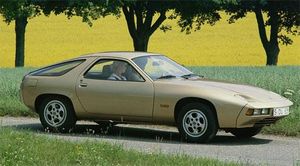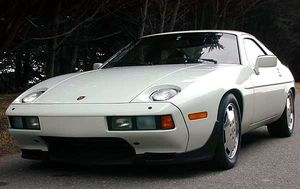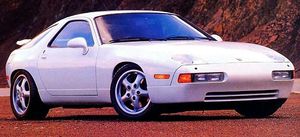.
Porsche 928

| |
| Porsche 928 | |
|---|---|
| Porsche | |
| aka | Porsche 928 S Porsche 928 S2 Porsche 928 S4 Porsche 928 GTS |
| Production | 1977-1995 |
| Class | Super Luxury |
| Body Style | Coupe |
| Length | 4447 mm |
| Width | 1836 mm |
| Height | 1313 mm |
| Wheelbase | 2500 mm |
| Weight | 1450 KG |
| Transmission | 5-speed Manual 3-speed Automatic |
| Engine | 90-degree V8 |
| Power | 240 BHP - 928 310 BHP - S and S2 316 BHP - S4 340 BHP - GTS |
| Similar | Ferrari 456 GT Maserati Quattroporte |
| Designer | Tony Lapine |
The Porsche 928 was a front-engined sports car produced by Porsche from 1977 to 1995.
European Car of the Year
Porsche was still a young company when the 928 coupe was released - barely 28 years old. The 928 marked a radical departure for the company, a change in direction from the slowly developing 911 model, with quirky dynamics, to a visually arresting V8 powered front engined coupe, with flawless 50/50 weight distribution and lavish use of exotic materials such as aluminium and polyurethane - both still in their infancy, as far as car manufacturing was concerned. The 928 was to be a technical masterpiece for the young company, and would certainly put the small Stuttgart concern on the supercar map.
The looks, in the launch year of 1978, were like nothing before seen on a car - even in science fiction films. The long, sleek bonnet, and cab-backward stance screamed performance and sophistication, with the smooth front and rear bumper sections showing very few signs of US-obligatory crash protection - the market for which the 928 had undoubtedly been built for. Despite the American influence to the design, the car won the 'European Car of the Year' gong in 1978, and remains to this day the only supercar ever to win the award - testament to the universal appeal of Porsche's new model.
911 Replacement?
When the 928 was released, it was unquestionably the flagship of the Porsche range. It cost more than the 911 (by a considerable sum), and featured so many enticing features that meant it could play no other part in the range. Features that included the captivating, and crowd-splitting, styling, the slightly odd standard-fit Pirelli P7 tyres, the luxurious interior, comprising of super-ergonomic seats, sweeping dashboard and high levels of equipment. The spec sheet featured air conditioning, leather trim and electric windows and mirrors all as standard fitment - which was up there with the most luxurious cars produced by prestige manufacturers.
From the start, Porsche declared that the vehicle was intended to replace the 911. Porsche board members felt that the 911 was just too quirky and outdated to continue attracting buyers, and demanded a replacement model - with a conventional front-engine chassis. This caused argument with the Porsche family, who believed that the 911, given successful tweaking, could continue well into the future. Despite such fracas, the project was greenlighted in the early 1970s, and the development went ahead in earnest.
The heart of the car was to be a 90-degree V8, naturally aspirated and of 4.5 litre capacity. The block was cast from alloy, but the engine was of rather basic design, which caused some media questioning. Fuel economy was not brilliant either - a risk Porsche took by launching the car into a newly aware market educated by the world energy crisis. Porsche engineers spent a large period of time developing the rear transaxle, their efforts culminating in the 'Weissach Axle'. Named after the test track at which it was honed, the new technology unique to Porsche allowed active movement of the toe-in of the rear wheels - the benefits of which included optimised lateral grip through corners.
The project hit its first obstacle mere months into its development - it was caused by its little brother, the Porsche 924. The decision was made to focus all company efforts on this model, to get it on the market as quick as possible in an effort to recoup money which Porsche had spent buying the project. The stillborn 928 was hidden under a dust-sheet until the 924 was finished. Just think how futuristic it would've looked had it been released on time.
The 928 Coupe
After its launch to the press in late 1977, the 928 was the subject of many a debate. The styling proved too trendsetting for some - others loved it. Opinion was further divided by engine choice - the relatively basic 90-degree V8, with the capacity of 4.5 litres. Why was such a car saddled with a positively archaic engine? The misconception of being a Mercedes-Benz, built on the other side of Stuttgart, was fostered by the announcement that the three-speed automatic gearbox would be from Mercedes - ironically, this proved to be the weak point of the car, as it was laggy, sluggish and power-sapping. To compound the irony, 85% of 928s going to the USA were specified with the automatic gearbox.
The opinion over the car was united after the driving, though - Road and Track declared that 'to drive the 928 is to love it - the standard by which all GT automobiles will be judged'. The sales were strong throughout the first few years of the car's life, but the competition from Modena and the rest of Germany caught up. The relatively low power output of 240BHP was easily trumped by other manufacturers, and Porsche, forever wanting to be seen the leader, consequently updated the 928 in 1980.
===The 928 S Coupe===
The 928 S was released to European markets in 1980 (it was released as the 'Competition Pack' in the US in 1981, before becoming a separate model in 1985), and was essentially a minor tweaking of the car to keep interest and strong sales in the car. Visually, new 'Flat Front' forged alloy wheels were added, along with front and rear black rubber valances. Inside, more gadgets were added, such as power-operation for almost everything and leather options for the seats. Colour charts were 'modernised', and power was boosted slightly. The new body treatments were typical of the period, although some voiced their concerns at the time - they believed that the original 928 shape was being diluted too much.
The car kept on finding fans with the press and customers, and its reputation grew as both a driver's car and a continent-crushing GT. Features, such as the revolutionary Weissach Axle, which had been on the car since the start, continued to amaze. The system actively controlled toe-in of the rear wheels to prevent oversteer, something that had never been attempted before by any manufacturer.
The American 928 S lasted from 1985 to 1987, and benefitted from a brand-new 32-valve iteration of the V8. The block was bored to a five litre capacity, and power soared to greater than 300 bhp. The model renewed flagging interest in what was now looking a rather dated car - but Porsche USA realised that a model revamp was needed, and began to badger Weissach.
The 928 S2 Coupe
The S2 is regarded as the first true upgrade to the 928. It arrived in 1983 (to Europe) and the upgrade saw power boosted to 310BHP (90BHP greater than the first model), cementing the 928's reputation as a supercar. The 0-62 mph time dropped to 6.5 seconds. No visual differences over the 928 S were present, apart from the 'Wide Track' option - this allowed buyers to specify wider rear alloy wheels, and improved power delivery and corner handling. The interior equipment levels soared to include air conditioning, cruise control, leather seats with power adjustment, AM/FM/Cassette stereo, metallic paint, electric windows and electric mirrors as standard-fit equipment.
Period press gushed: 'Nearly a five years on, the 928 continues to entrance.'
Moving Forward - the 928 S4
To European markets, the 928 S4 signalled the arrival of the 32-Valve 5.0 litre engine - which the US market had been supplied as the 928 S 32V. The S4 arrived in 1987, and replaced the 928 S2. The new engine featured 316BHP, with 0-62 mph arriving in 6 seconds dead - impressive, considering the basic design of the car was now over a decade old.
As well as the sophisticated new power plant, the 928 S4 had significantly cleaner lines over the previous models, due in large to the modified front and rear bumpers, and an additional rear spoiler hugging the bottom of the hatch. Interior specification included a new seat design (though still with the ergonomic padding), and further revisions to colour schemes - the introduction of the popular 'Linen' leather most notable.
Redesigned transmissions complimented the increase in power - the autobox now featuring four ratios, and the standard-fit (but still unpopular) manual gearbox featuring five.
The 928 S2 was beginning to show its age - the 928 S4 blew away the cobwebs and created a 928 for the 1990s.
===The GTS===
A massive 16 years after it was unveiled, the 928 was updated for the final time in 1992, (although not introduced in the States until 1993). The company, still reeling from the recession, had suffered a downer on sales, with models across the board selling poorly - the 964 was showing its age, and the 968 had disappointed the company with its sales. The whole model range had its roots in the 1970s. Despite this, the final fling for the 928 produced the most stunning looking derivative yet.
The muscular arches, pumped to accept a wider track, hinted at the power increase. The V8 had been bored out to 5.4 litres, and power was up by 20BHP. The range-wide 'Cup One' alloys were fitted to the car, along with sleeker 'Cup' mirrors. A new range of exterior colours (including the 'colour match to sample') were available, and equipment levels were the best yet - to travel in a 928 GTS was to travel in the lap of luxury. Every gadget was there : from trick Blaupunkt stereo to active air conditioning, via electric heated seats with memory and cruise control.
Porsche soldiered on with the manual gearbox option, but the same 4-speed auto fitted to the S4 was available, and as always, this was the bulk seller.
Sales were not expected to be strong, as the early-1990s were not the best time to sell a £90,000 motorcar. By the end of production in 1996 (sales ended in the US in 1994), production figures showed double figures. The last vehicle ever to be produced was an automatic GTS, finished in sample Lime Green metallic with sample purple leather interior, with matching purple carpets and dash. A fitting end to a model that personified excess.
Summary of Models
Europe
- 1978-1980 - Porsche 928 Coupe
- 1980-1982 - Porsche 928 S Coupe
- 1982-1987 - Porsche 928 S2 Coupe
- 1987-1993 - Porsche 928 S4 Coupe
- 1989 - Porsche 928 GT/Clubsport Coupe - lightened bodyshell, 40kg under standard, forged wheels, stiffer suspension, manual gearbox only.
- 1993-1996 - Porsche 928 GTS Coupe
USA
- 1978-1983 - Porsche 928 Coupe
- 1981-1983 - Porsche 928 'Competition Pack' Coupe
- 1983-1987 - Porsche 928 S Coupe
- 1987-1993 - Porsche 928 S4 Coupe
- 1993-1994 - Porsche 928 GTS Coupe
Racing Efforts
Porsche never made a works effort out of the 928 - sources say that they were scared that it would dominate over the 911, which Porsche saw as their flagship racing model. The closest Porsche got was to create a semi-works racing car with Swiss racing team, Max Moritz Racing. For the car, dubbed the 928GTR, Porsche supplied its factory racing drivers Bernd Maylander and Manuel Reuter, and Porsche CoD Harm Lagaay made a guest appearance at certain races. The engine came from the standard 928 GTS production line, but was fettled by Strosek, who supplied a free-flowing exhaust and lightweight body parts. The 1370KG machine raced in the 1994 German GT championship, and was quite competitive, setting lap times faster than some contemporary 911s. However, after a glimmer of promise in the 1994 season, 928 production ended in 1995 and the car was no longer raced. It resided in Max Moritz's personal car collection, before being sold on in 2004.
Despite Porsche's deliberate undermining of the 928's racing efforts, privateer teams have run examples in numerous championships around the world, and many cars are still in competition. Notable appearances include the 1983 Le Mans, where French team Raymond Boutinaud campaigned a 928 S - however, it completed only 234 laps before retiring. The team returned the next year, finishing 22nd.


